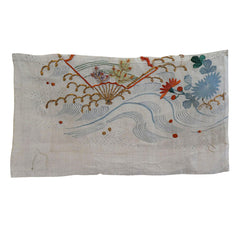A Fragment from an Eighteenth Century Katabira: Folding Fan, Pine, Couched Gold Waves
late eighteenth century
7 1/2" x 13", 19 cm x 33 cm
Shown here is a treasure, something of an indication of the kind of masterful weaving, dyeing and needlework that was done--quite literally--centuries ago in Japan and is now lost to time.
This is a fragment from a katabira or a kind of hyper-elegant, unlined summer garment worn by women in the upper echelon of Japanese society. Katabira of this era for samurai women are distinctive in their decoration and usually had a kind of distinguishing "look" about them: this fragment beautifully captions the decorative and integral essence of this kind of katabira.
It is woven from the finest asa or bast fiber, more than likely Echigo jofu, which is super fine, snow bleached ramie cloth which is one of the glories of the Japanese loom. Once this superior cloth was woven in Niigata prefecture it was most likely sent to Kyoto where the dyed, couched and embroidered decoration were applied.
Yuzen dyeing produced the beautifully drawn chrysanthemums which grace the design to the right of the intricately hand embroidered folding fan.
The suggestion of a soft breeze that passes through this scene is due to the judiciously noted, stylized stream which supports the design is depicted in medium indigo tones. Expert silk embroidery augmented this scene and we see the colors of nature in the dye of the silk.
Purple is gromwell root, orange is safflower, green is over dyed indigo.
The gold couching which was relegated to define the softly lapping surf is fairly unbroken, somewhat abraded and beautifully done.
The cloth of this fragment is still beautifully white in appearance, the embroidery is all in good condition--rather astonishing considering the age of this piece.
This is a spectacularly beautiful fragment of a super luxurious cloth from what had to have been a remarkably fine kimono from the late 18th century.
Recommended--and how beautiful would this look framed.


